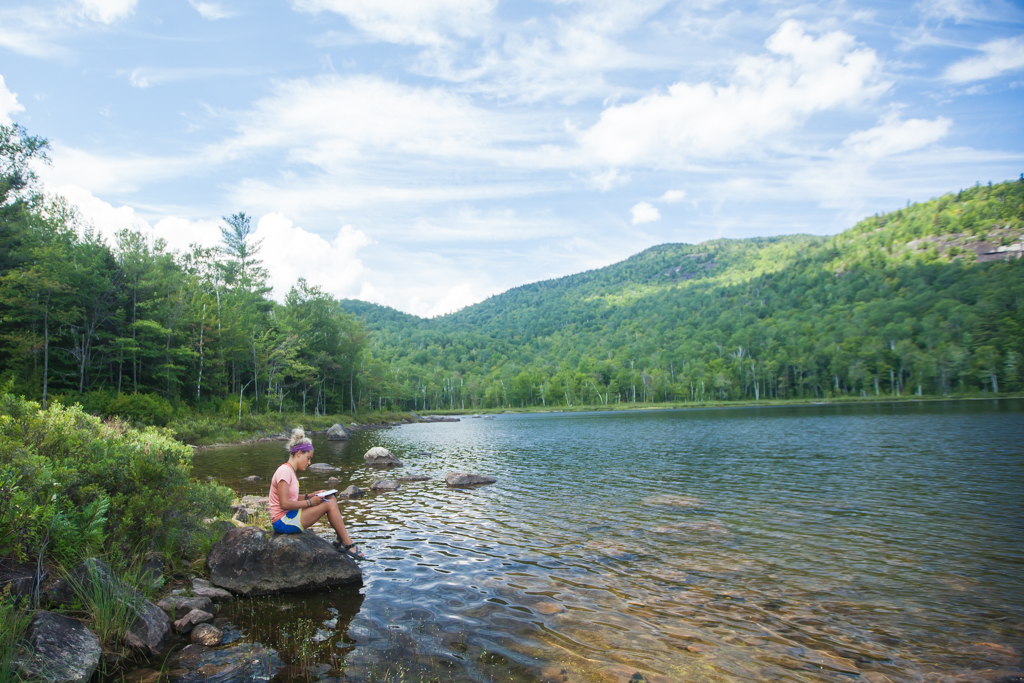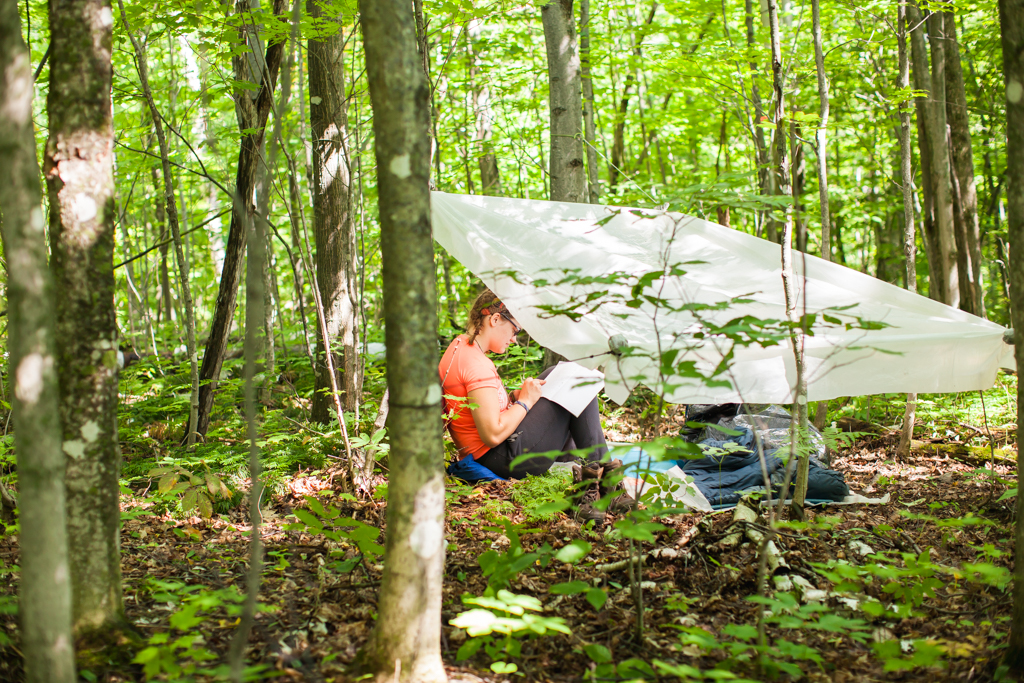By: Taylor Bradford ’19
“The silence of the forest, the peace of the early morning wind moving the branches of the trees, the solitude and isolation of the house of God: these are good because it is in silence, and not in commotion, in solitude and not in crowds, that God best likes to reveal himself most intimately.” —Thomas Merton, Trappist Monk
Time is a precious entity that we never seem to have enough of. The hours turn into days, days to weeks, weeks to months, and before we know it we have raced through life without much time to process any of it.
As the La Vida Center provides students with the opportunity to step outside of their comfort zone through backpacking and canoe trips, we also offer a time and space for students to rest and reflect on their experiences in and beyond the woods. Including a time of solitude in our trips, known as “solo”, encourages participants to ask the question: How often do I take time to sit in silent solitude, especially after strenuous experiences?
“Solo is a key component of the La Vida wilderness expedition because it puts people in touch with God like no other component,” said founder, Rich Obenschain. “As students adjust to the silence, solitude and simplicity of their solo, God can get their attention and lead them to devotion and prayer. Sitting alone in the woods, fasting, spending the night without a flashlight can help students depend on God like no other time in their life.”

Basic Framework of the La Vida Solo
For our twelve-day trips, the solo lasts two days and two nights. For our 10-day trips, solo goes on for one day and one night. Participants are no more than 150 feet (by land) from each other. They are provided adequate shelter, plenty of water and warm layers. The trip leaders visit each student at least twice a day and all students have a whistle in case of emergencies.
Health and safety
The night before the solo, each group discusses the intricacies of what the next 24-48 hours will look like. Participants are closely monitored and provided with proper nourishment before and after the solo to ensure their well-being.
Special circumstances
For those who require an adapted experience due to medical restrictions, solo may look slightly different. Those students might not fast, or they may be placed in camp with the Sherpas, or they might have an additional form of shelter at their solo site. Once participants have been assigned to a group, individuals can talk to their Sherpa about how solo time can meet their specific needs.
Church groups and schools
Church groups and schools can work with their assigned Sherpa’s ahead of time to discuss how they would like solo structured during their La Vida trip.
Spiritual and health benefits of fasting
During the solo, participants can practice the spiritual discipline of fasting. We encourage them to lean into this discipline with the mindset of reflection. While we acknowledge that this is an unusual practice for most, we have found that abstaining from food for this short time gives participants the opportunity to rely on Christ and the Word for spiritual nourishment. (Dan. 9:2-3; Acts 13:2; 2 Chron. 20:1-4)
In addition to the spiritual benefits that come from fasting, there are key health benefits. Scholars such as Mark Mattson, senior investigator for the National Institute on Aging (part of the National Institutes of Health), have concluded that intermittent “fasting has been shown to improve biomarkers of disease, reduce oxidative stress and preserve learning and memory functioning.” Mattson determined that if you give your body a sufficient amount of time to recover through fasting after physical exertion, it is more apt to grow stronger—building up resistance to diseases, managing stress and improving your ability to retain information.

The Primary Goals of Solo
The goals of the solo are rest, reflection and self-renewal.
Rest
Personal growth happens when people overcome challenges. During our Adirondack Expeditions, challenges can take the form of carrying a heavy backpack up a mountain, portaging a canoe to the next access point or not showering for twelve days. However, with our students we emphasize that personal growth does not only come from physical challenges.
Rest is a vital part of the Adirondack Expedition as we strive to catalyze character formation, cultivate community and develop servant-leadership skills. Without rest, our physical and mental abilities diminish and exhaustion sets in. The 24-48 hours of solo are spent in quiet so when participants return to their group, they feel replenished and prepared to grow within their communities.
“La Vida is a lot of hard work, so the solo felt nice because it was like a rest from all that hard work. I got to read a lot of Scripture that helped me to understand God, myself, and the world around me better.” — Aiden Perez ’22
Reflection
With any journey, it is important to think deeply and critically about the experience so that the lessons learned can be practiced in the future. On solo, participants have the time and space to do guided reflections. They are given a journal with reflection prompts. Even before the solo, participants journal daily, so when it comes time for the solo they can look back at what they have learned so far.
“[Solo] itself creates an atmosphere for reflection,” said Stephanie Boettiger ’19. “I used my time, being completely immersed with nature, to communicate with God and find ways to be in awe of all the little lessons he taught me.”
Self-renewal
In a society where we are constantly being bombarded with false ideals of how to think and act, time away from these distractions can help individuals recover who they want to be. By providing students with the time to reflect on their past, present and future, our hope is that they emerge from their solo to take “hold of the life that is truly life.” (1 Timothy 6:19). During this time, participants are encouraged to grow deeper in their relationship with Christ, reflect on relationships in their lives and set goals for how they want to implement what they’ve learned on La Vida. Being able to do this without the distraction of daily routine can help give students a fresh perspective.

History of Wilderness Solos
The solo has been part of Adirondack Expeditions since the program began back in 1970. However, this act of reserving time for reflection, rest and self-renewal in the wilderness began long before La Vida Adirondack Expeditions and far beyond New England.
The roots of intentional rest can be traced back to biblical times when the Lord called for his people to take a weekly day of rest. Known as Sabbath (or Shabbat), this time is set aside to meditate on scripture, worship and celebrate God’s creation (Genesis 2:1-3.)
When it comes to practicing an intentional time of rest and reflection in an adventure setting, we look to Kurt Hahn and Tap Tapley who brought solo to the Outward Bound experience in Colorado in 1961. What first started as a survival school changed into an expedition for growth and personal reflection, by 1970. Today, most outdoor education programs aren’t simply teaching students survival skills. They emphasize the value of self-reflection.

A Message to our Future Participants
As you prepare for your Adirondack Expedition, begin to think about how you want to spend time on your solo experience. Maybe you will spend it listening to the silence of the forest, enjoying the peace of the morning wind, or marveling in the solitude of unfamiliar places? As Merton puts it, “these are good because it is in silence, and not in commotion, in solitude and not in crowds, that God best likes to reveal himself most intimately.”
Sources:
Collier, Roger. “Intermittent fasting: the science of going without.” CMAJ: Canadian Medical Association Journal, 11 June 2013, p. E363+. Academic OneFile, http://link.galegroup.com/apps/doc/A334710036/AONE?u=mlin_n_gordon&sid=AONE&xid=82547612. Accessed 6 Dec. 2018.
Knapp, Clifford, and Thomas E. Smith. Exploring the Power of Solo, Silence, and Solitude. Association for Experiential Education, 2005.

Taylor Bradford’s first La Vida experience started as a Counselor in Training at our Adventure Camp. Since then she has been an Adventure Camp Counselor and Photographer, Adirondack Sherpa, Adventure Pursuits Facilitator, Discovery Apprentice and now a La Vida Intern. She is a Communication Arts major at Gordon College.
